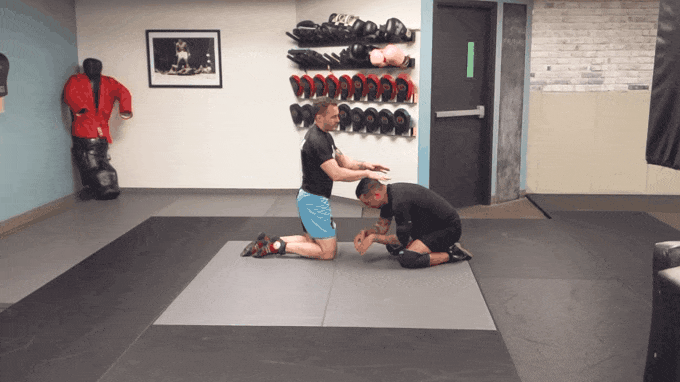This is a late recap on chokes from front headlock. We will look at several chokes from the position, all of which will involve having one arm inside the choke, in the classic triangle shape. The idea is that one of my arms will constrict blood flow on one side of my opponents neck and their own trapped arm will constrict the other. Each of these chokes has its own advantages and disadvantages. All of these chokes begin from the same position. We have a grip with one arm along our opponents neck and the other under their armpit, hands clasped beneath them. Different grips will favor different chokes, but we generally want to hold our opponents head in the middle of our chest and use our elbow to keep them there. If their head begins to pop out our armpit they are closer to hitting a sit out style escape.
The Anaconda Choke
The anaconda choke can be a very strong choke, especially if you have larger arms. It does involve rolling to finish, but the actual entry is reasonably low risk. In some of our later chokes we will need to give up position to get the appropriate grip for the choke, but the Anaconda allows us to stay on top until our grip is secure. Beginning from front headlock, the first step is to collapse the trapped arm, pushing the elbow across the opponents midline. This can be done with your own elbow, without releasing the grip. Once, the elbow is collapsed we hold it in position with our palm and sink the other arm as deep as possible. For the Anaconda the choking arm goes in the neck and out the armpit. This is the defining feature of the choke. Once the choking arm is as deep as possible, it will grab the bicep of our other arm forming a ‘rear naked choke’ style tie. From here, we look to duck our head and roll our opponent. To finish the choke it is helpful to put pressure on the back of the opponents head to compress their neck further onto our arm. It is my preference to do this by rolling to my back and bridging. From here they cannot post their arms to the mat to make space along their throat. Additionally if they are not tapping, I am free to continue my roll to the more conventional finish, hooking their legs with my own. As such it doesn’t cost me anything to try to finish off my back but frequently it feels like I am less likely to lose the choke.
The Darce Choke
The Darce choke is the Starbucks coffee of chokes. Some people are absolutely obsessed with it and It is available almost everywhere. The Darce is very similar to the Anaconda, the main difference being that in the Darce the choking arm goes in the armpit and out the neck, the opposite of the anaconda. This motion is hard from front headlock, but is what makes the choke available is so many more positions than the anaconda. From front headlock it is necessary to sacrifice the position in order to sink the choke to an effective depth. Placing one hand on the head we roll to our own flank or back, driving the choking arm as far through the armpit and out the neck as possible. It is important to remember that this is very difficult with the arm bent, it needs to straighten then bend again to get a good grip. You need to open your pliers as wide possible to get the best grip on a bolt, your elbow is the same. From here we again grab our opposite bicep and roll our opponent, this time progressing all the way to the top and walking our hips across to a side control like position. This motion is so that we can use our ribs to maneuver their trapped arm into position along their throat so that when we sprawl our weight down to finish we don’t press the arm into their face allowing them space for blood flow.
As mentioned, the darce is an option from almost everywhere. We looked at it from Top Half, Butterfly, and Full guard, but it is also available from bottom half, bottom side control and many other spots. This piece however is only addressing front headlock.
The Peruvian Neck Tie
This begins similar to a Darce choke in that the choking arm moves from the armpit to out the neck. However, unlike the Darce it does not need to be as deep. Instead of aiming to get our bicep to make contact with their throat, we only pull our hands out enough to get our wrist bone along the throat. From here it is best to switch to a Gable Grip and use the top arm to compress their head. The next step is to lean our head toward their hips so that we can step our head side leg up and over, covering their head with our hamstring. lastly we need to get our hip side leg up and over their back in a similar manner. From here we stomp both out feet away and pull hard on our arms for the finish. Although we could apply a significant amount of force with only the single leg over the head, the second leg is necessary to be able to stop them from front rolling out of the choke. Be quick about it, as this is the moment we are most likely to lose the choke.
The Unicorn Choke or Head and Arm Guillotine.
This is the choke I use the most from this position. The main reason I like it so much is that I give up very little to attempt it. If I go all the way to finishing position and the person does not tap, I can unwind the whole thing back to front headlock and it has cost me nothing. This is not true of regular guillotines or for that matter all of the other chokes on this post. If you take them to their conclusion and they do not work, you have usually lost a dominant position for your efforts.
In the unicorn choke we would like to collapse our opponents trapped elbow as we did in the Anaconda. However, because we will need more space this time it is preferable to use our knee instead of our elbow. Circling toward the trapped arm, we make space with the hip side knee, digging it in the armpit and forcing their arm toward their head. From here we pull both our hand far out the armpit, again looking to connect our bicep to their throat. Both our hands should be well clear of their armpit. Next we switch our head side knee into the space the hip side knee created. Sitting to our but, we hook the top of our inside foot on to their hip and throw our other leg over their back to prevent the front roll. The finishing pressure should come from driving them away with our legs (to my right in the example) and ‘rocking the baby’ in the opposite direction (to my left in the example). We want to crunch forward with our abs, keeping our shoulder blades off the mat, not to arch backward and risk their head popping out.
Because the in the finishing position we have maintained what is essentially an armdrag and kept our legs on one side of our opponent, we can kick them off of us and regain first our knees, then front headlock, without breaking our grip.
The Impaler
This one seems a little gratuitous at first but it can be useful. The main reason I will check down to this choke is if I am working a Unicorn as above but cannot create space enough for my knees. Instead of attempting to pull guard, we lay our ribs along the back of the opponents head forcing it down as at the same time we pull to roll them all the way over us. Once the roll is finished we should be belly down on the mat with our opponent laying belly up, their head resting on our back. The grip has not changed and we need only squeeze.







